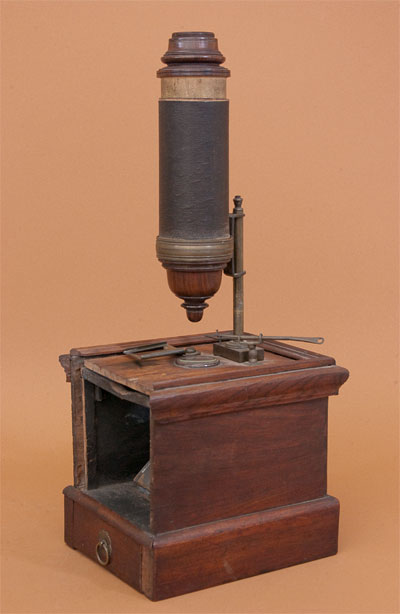 |
|||||
 |
 |
||||
 |
|||||
 |
 |
||||
French Box Microscope by Guillaume Ménard (No. 125) |
||||||||||||||
 |
Age: 1739 Made by: Guillaume Ménard (II) Made in: Paris, France |
|||||||||||||
 |
||||||||||||||
|
Universal Microscope
made and much improved by Guillaume Menard merchant in mirrors for optical articles in Paris Quay de l'Orloge du Palais called des Morfondus, at the Sign of the Good Shepherd 1739. |
||||||||||||||
 |
||||||||||||||
|
Imaging
|
||||||||||||||
|
This type of instrument is known as a "box microscope". It is a compound microscope with three lenses (eye, field, objective) mounted on a supportive box-like base. The eyepiece and field lenses are mounted in the inner drawtube. The objective is mounted to the lower, outer body tube. The body tube is covered with black fish skin, whereas the inner tube is covered with white parchment. The eye and objective lenses are mounted in turned "Acajou" (any of a number of dark hardwoods, all called mahogany). The field lens is set at one end of the inner body tube and is fastened by a softwood mount (probably pine). This instrument has a friction focus, which makes fine focusing on the sample extremely difficult. There are four objectives with this microscope. The fine imaging of this microscope attests to the skill of Ménard. This specimen was microscope #32 of the former Nachet Collection. The front section of the wood box slides out to expose the mirror, which is used to reflect the light up through the glass-topped hole in the top of the box. The angle of the mirror cannot be adjusted as it can in more contemporary box microscopes (e.g., No. 127). There is one accessory drawer accessible from the front. It contains three additional objectives (one missing the lens), four glass slide preparations (two insect, two plant) and two wooden sample holders (minus samples). The stage is a simple brass holder for the wide, glass slides. It can be rotated in and out of the optical path. The only accessory is a specimen forceps mounted permanently on the top of the box. The microscope is 40cm tall, on a mahogany base that measures 14(w) x 17(d) x 16cm. The back of the front section of the box has an inscription on paper with the name "Guillaume Ménard" and the date "1739." The inscription on this paper shows that the microscope was made by G. Ménard in 1739. According to M. Morizet* this is the condensed history of the Ménards of Paris: The Ménards : A Family of Opticians during one century. The story of this dynasty of “faiseurs de lunettes” can be written succinctly. Guillaume Ménard I started working before 1651 when he was already well known. He died probably before September 1667. He worked in particular for C. Huygens. He had one son called Siméon. It is possible that he had a second son. Siméon Mesnard is probably “Menard le fils” or “Menard le jeune” as Huygens called him. He started working around 1667. He signed some lens and a microscope (1668). He had probably a shop at the Sign “A LA BELLE ETOILE” The last date for him is 1718 but this date is unrelated to his death. Guillaume Ménard II can be the son of Siméon, (or his nephew) or his grandson! He had a shop “Quay de l’horloge du palais called des Morfondus entering the side of bridge of Change, at the Sign of the Good Shepherd in Paris”. We have only two dates for his activity: 1739 and 1743 corresponding to the Golub (formerly Nachet’s) microscope and a small book. *Thanks to Michel MORIZET Versailles France This microscope was No. 32 of the Nachet Collection of Paris. |
||||||||||||||
| Featured 04/2006, 01/2010, 06/2020; 02/2024 | ||||||||||||||